横空出世的千里运河图
- 2021-06-22 15:36:56
- 点赞量:13499
- 点击量:216977
- 作者:郝连成 Hao Liancheng
题记:
Inscription:
大运河是祖先留给我们的宝贵遗产,是流动的文化,要统筹保护好、传承好、利用好。--------习近平
The Grand Canal is a precious heritage left to us by our ancestors and a flowing culture. We should protect, inherit and make good use of it as a whole-------- Xi Jinping

近日,我国著名山水画家,界一刘伟先生的鸿幅巨作《千年国脉盛世大运河》经中国美术大师范扬教授题名后,耗时五年,总长319米的长篇巨制总算大功告成。
Recently, a famous landscape painter in China, Mr. Jieyi Liu Wei's masterpiece Grand Canal in the prosperous age of the millennium, was named by Chinese art master Professor Fan Yang. It took five years and a total length of 319 meters to complete.
在首都副中心通州的成杏堂艺术创作中心,见到界一先生的这幅作品时,笔者被这幅鸟瞰(浓缩)中国大好河山于百丈之间的大家手笔所震撼。难怪界一先生的老师范扬教授看后惊呼这简直就是现代版的《千里江山图》”,并欣然提笔题写《千年国脉盛世大运河》!
When I saw Mr. Jieyi's agent, Ms. Wei Ping, opening this work for me at chengxingtang art creation center in Tongzhou, the capital's vice center, I was shocked by the bird's-eye view of China. No wonder Professor Fan Yang, the teacher of Mr. Jieyi, exclaimed that this is a modern version of the painting of a thousand li River and mountains, and took the initiative to Title The work.

山水画家刘伟(刘鏵),号界一,1966年生于山东济南,进修于中国国家画院范扬工作室,现为中国美术家协会山东分会会员,中国中央名人书画院副院长,北京成杏堂书画研究院院长,山东泰山书画院副院长,中国民主促进会(山东)开明书画院常务理事,成杏堂(北京)国际文化传播有限公司艺术总监,很多作品曾获各类书画展奖项。
Liu Wei was born in Jinan in 1966. He loved painting since he was a child. He graduated from Shandong Academy of art and studied in the National Academy of painting. He is now a senior painter of Shandong Academy of painting, vice president of Shandong Taishan Academy of painting and calligraphy, executive vice president of Jinan Wendu Academy of painting and calligraphy, vice president of Jinan Lixia celebrity Academy of painting and calligraphy, and vice president of Jinan Academy of traditional Chinese painting and oil painting.
笔者八年前曾采访过刘伟先生,写出过《胸中有天地山川入画来》专访文章。
The author interviewed Mr. Liu Wei eight years ago and wrote an interview article entitled "heaven, earth, mountains and rivers in my heart".
后来知道他又创作出了《方山神韵》等一批表现祖国大好河山的作品。
Later, I learned that he had created "the charm of Fangshan" and other works to show the great rivers and mountains of the motherland.
从那以后,刘伟就有一种想创作一 幅能表现中国改革开放后这些年天翻地覆变化的作品。
Since then, Liu Wei has wanted to create a work that can show the earth shaking changes in the past few years after China's reform and opening up.
习近平总书记为保护大运河的批示,使刘伟找到了突破口和创作方向,他要创作一幅"千里运河图”。当刘伟把这一想法告诉夫人魏平时,得到了夫人的全力支持。
In order to protect the instructions of the Grande Canale, general secretary Xi Jinping made Liu Wei find a breakthrough and creative direction. He wanted to create a "thousand Li canal map". Record the changes of the great times. When Liu Wei told his wife Wei Ping about this idea, he got her full support.
千里考察 回望历史
Looking back on history
中国大运河北起通州,南接余杭,途经8省19市,激流长泻千里,汇入钱塘江,是世界上最长的运河。2014年成功入选世界文化遗产名录。
The Grand Canal of China starts from Tongzhou in the north and connects Yuhang in the south. It passes through 19 cities in 8 provinces. The torrent flows thousands of miles and joins the Qiantang River. It is the longest canal in the world. In 2014, it was successfully included in the world cultural heritage list.

319米长卷《千里运河图》(局部)
319 meter long scroll "the painting of Qianli canal" (partial)
为了更加真实地表现出大运河的面貌,观察大运河两岸的秀美风光,魏平亲自驾车带着画家刘伟,从通州的运河起点,一路沿大运河南行,考察采风。
In order to more truly show the face of the Grand Canal and observe the beautiful scenery on both sides of the Grand Canal, Wei Ping personally drove with the painter Liu Wei from the starting point of the Grand Canal in Tongzhou, all the way south along the Grand Canal to investigate the wind.
大运河始建于春秋时期,当时是为军事服务的,隋朝统一天下后贯通南北而转为经济服务,至元代全线贯通,明清两代成为南北水运干线,在世界运河史上,中国大运河,开凿最早、河流最长、工程最大。它一路逶迤,翻山越岭,跨海河、黄河、淮河、长江、钱塘江五大水系,贯通南北,留下了中华文明的辉煌一笔。
The Grand Canal was first built in the spring and Autumn period. It served the military at that time. After the Sui Dynasty unified the world, it connected the north and the South and turned into economic service. In the Yuan Dynasty, it was connected all the way. In the Ming and Qing Dynasties, it became the main line of water transportation between the north and the south. In the history of the world canal, China's Grand Canal was the earliest excavated, the longest river and the largest project. It stretches all the way across the mountains, across the Haihe River, the Yellow River, the Huaihe River, the Yangtze River and the Qiantang River, connecting the north and the south, leaving a brilliant record of Chinese civilization.
为了更加全面地了解运河的历史和现状,魏平还帮助刘伟查阅了大量的资料,特别是找来了全国政协委员老舍之子舒乙先生考察运河后写出的《京杭大运河,残缺的辉煌》、《隋唐大运河,地下的辉煌》和《江南运河,水乡的辉煌》三篇考察实录。通读了《随炀帝传》分别从正史,野史和民间运河两岸的传说故事中筛选素材。刘伟认为,运河和长城一样是伟大的奇迹,都是世界上了不起的伟大工程。通过对运河的考察和历史的解读,刘伟对运河的沧桑历史有了更深一步的解读,也对运河是我国的“宝贵遗产和流动文化”有了更深刻的认识。
In order to have a more comprehensive understanding of the history and current situation of the canal, Wei Ping also helped Liu Wei to consult a large number of materials, especially three investigation records written by Mr. Shu Yi, the son of Lao She, member of the National Committee of the Chinese people's Political Consultative Conference, after inspecting the canal: "Beijing Hangzhou Grand Canal, incomplete brilliance", "Sui and Tang Grand Canal, underground brilliance" and "Jiangnan canal, water town brilliance". Read through the biography of emperor Suiyang and select materials from official history, unofficial history and folk legends on both sides of the canal. Liu Wei believes that the canal, like the Great Wall, is a great miracle and a great project in the world. Through the investigation and historical interpretation of the canal, Liu Wei had a deeper understanding of the vicissitudes of the canal history, and also had a deeper understanding of the canal as China's "precious heritage and mobile culture".

正是:
It is this:
雄浑大运跨京杭,南北通漕千里长。
八省相连兴贸易,五河纵贯富工商。
物流顺畅财经活,城邑繁生文化昌
功过谁评留青史,任凭遗产世无双。
The Grand National Games spanned Beijing and Hangzhou, and the north and South were connected by water transport for thousands of miles.
Eight provinces are connected to promote trade, five rivers run through rich industry and commerce.
Smooth logistics, lively finance and economy, prosperous city and prosperous culture
Those who have merits and demerits will remain in the history of the Qing Dynasty.
构思作品 数易其稿
The idea works are easy to write
此时在画胸中是长河奔涌,养育千年生灵;运河两岸,传承历代文化:聊城故邑, 孙武子研习《兵法》;淮安重镇,吴承恩编纂《西游》。梁山水泊,施耐庵笔下《水浒》;济宁名郭,孔夫子修订《春秋》。泰安鲁地,左秋明集成《国语》。.这些齐鲁大地的历史,正是生长于斯,滋润刘伟成长的根基沃土,每一-段历史故事都会与画家产生共鸣。
At this time, in the chest of the painting, there is a long river, nurturing thousands of years of life; On both sides of the canal, inheriting the culture of the past dynasties: in Liaocheng, sun Wuzi studied the art of war; Wu Chengen compiled a journey to the West. Liangshan water park, Shi Naian's water margin; Jining was named Guo, and Confucius revised the spring and Autumn Annals. In Lu Di, Tai'an, Zuo Qiuming integrated Mandarin The history of Qilu is the fertile soil for Liu Wei's growth. Every historical story will resonate with the painter.
而江南的姑苏寒山寺,无锡的太湖景色,杭州的龙井茶香,钱塘江的仲秋潮涌,种种水乡风光更加激起了刘伟创作激情。
The Hanshan Temple in Gusu, the scenery of Taihu Lake in Wuxi, the fragrance of Longjing tea in Hangzhou, and the mid autumn tide in Qiantang River arouse Liu Wei's passion for creation.
千百年来,运河传承的都是中国的农耕水种的封建文化,从孙中山领导的辛亥革命推翻了清王朝,结束了在中国延续了两千多年的封建君主专制制度,特别是中国共产党领导建立的新中国,使中国真正走上了与世界潮流同步发展的轨道,通过近三十年的改革开放,使中国的面貌发生了天翻地覆的变化,中国已经赶上了世界发达的工业化国家。
For thousands of years, the canal has inherited China's feudal culture of farming and water planting. The 1911 Revolution led by Sun Yat Sen overthrew the Qing Dynasty and ended the feudal autocratic monarchy system that lasted for more than 2000 years in China. In particular, the new China established under the leadership of the Communist Party of China has put China on the track of synchronous development with the world trend, China's face has undergone tremendous changes. China has caught up with the developed industrialized countries in the world.

刘伟要通过运河两岸的城市发展变化,来表现出中国的现代江山。
Liu Wei wants to show China's modern landscape through the urban development and changes on both sides of the canal.
经过半年多的前期准备,鸡年的秋月,刘伟铺纸调墨,开始创作。
After more than half a year's preparation, Liu Wei began to write in the autumn of the year of the rooster.
起稿之初,刘伟想创作- -幅能反映大运河全貌的画卷,想以运河为主线,通过长城,京城和运河沿岸的变化表现出中国改革开放后的伟大变化。
At the beginning of the manuscript, Liu Wei wanted to create a picture that could reflect the whole picture of the Grand Canal. He wanted to take the canal as the main line and show the great changes after China's reform and opening up through the changes of the Great Wall, the capital and the banks of the canal.
但是用平面直视的表现手法,总是感觉到不能把祖国大好河山的雄伟气势表现出来。
But with the expression of plane direct view, we always feel that we can't show the majestic momentum of the motherland.
这时,刘伟想到了电影艺术手法中的交叉蒙太奇的手法,把观众的目光定在空中鸟瞰的视角,来立体地表现运河两岸的景色。
At this time, Liu Wei thought of the cross montage technique in the film art, and set the audience's eyes on the aerial bird's-eye view to show the scenery on both sides of the canal in a three-dimensional way.
在色彩的运用上,他大胆地突破了国画黑白灰的基调,采用重彩作画。在这样创作思想的指导下,创作出的草稿,初具规模,但是画面除要表现山川河流农田稼禾外,还应承载着中国的历史文化,画面中除用长城代表悠久的中华历史外,刘伟在唐朝张继的:“姑苏城外寒山寺,夜半钟声到客船”诗句中受到了启发,把千里运河上的千年古塔收入画卷,不正能通过这些景物把读者带进历史吗?
In the use of color, he boldly broke through the tone of black, white and gray in traditional Chinese painting, using heavy color painting. Under the guidance of this creative idea, the draft has begun to take shape, but the picture should not only show the mountains, rivers, farmland and crops, but also carry the Chinese history and culture. In addition to using the Great Wall to represent the long history of China, Liu Wei wrote in the Tang Dynasty: "Hanshan Temple outside Gusu City, half night."Inspired by the poem "sound to the passenger ship", the ancient pagoda on the thousand mile canal is included in the picture. Can't these scenery bring readers into history?

于是画中就有了运河边上通州的燃灯塔;山东聊城的舍俐宝塔,杨州的文峰塔,西湖的六合塔。
So there is a lamp tower in Tongzhou on the edge of the canal; Shili Pagoda in Liaocheng, Shandong, Wenfeng Pagoda in Yangzhou, Liuhe Pagoda in West Lake.
伴随着这些古塔和长城的,一直是北方的青山绿水和江南的粉艳桃红,通过这些花红柳绿的画面,表现出了祖国蒸蒸日.上的强大生机。
Along with these ancient pagodas and the Great Wall, there are always green mountains and rivers in the north and pink peach in the south of the Yangtze River. Through these pictures of red flowers and willows, we can see the great vitality of the steaming day of our motherland.
而与之相应表现祖国巨大变化的则是沿运河两岸城乡的一些标志性建筑:
Correspondingly, the great changes of the motherland are represented by some landmark buildings in urban and rural areas along the two sides of the canal
有天安门的庄严,故宫的历史,天坛的神圣,中华尊的文化,鸟巢的现代,水立方的科学和盘古大厦的辉......
There are the solemnity of Tiananmen Square, the history of the Forbidden City, the sacredness of the temple of heaven, the culture of zhonghuazun, the modernity of the bird's nest, the science of the water cube and the splendor of Pangu mansion
说起刘伟对这样巨幅作品的把控,总体的指导思路是用老子的道法自然的理念含在其中,刘伟对道家思想颇有研究,从他的字号界一就可知道 ,刘伟解释他的界一来历,凡事都以一为界,一生二,二生三,三生阳,阴阳合和则生万物,所以万事万物都以一为界,要顺其自然。
When it comes to Liu Wei's control over such a huge work, the general guiding idea is to use Lao Tzu's idea of Tao following nature. Liu Wei has a lot of research on Taoist thought. We can see from his name Jie Yi that Liu Wei explains the origin of Jie Yi. Everything is bounded by one, one is born of two, two is born of three, three is born of Yang, and the harmony of yin and Yang is born of all things, so everything is bounded by one, Let it be.
生长在泰山脚下的刘伟深得齐鲁文化的滋养,多年来以“仁,义、礼、身、智、信”修身,以“道法自然”处世,以"-花-世界”心态去参悟人生。使他的作品里处处透着儒,释,道的柔杂,端庄大气中有虚无飘渺的灵动、现实山水中有种参悟天地的玄机。做画时始终提醒自己要眼中有世界,筆下有自我,他要畫出自己的個性。
Liu Wei, who grew up at the foot of Mount Tai, is deeply nourished by Qilu culture. Over the years, he has cultivated himself with "benevolence, righteousness, propriety, body, wisdom and faith", dealt with the world with "Tao following nature" and understood life with "flower world" mentality. His works are full of the sophistication of Confucianism, Buddhism and Taoism, the ethereal flexibility in the dignified atmosphere, and the mystery of understanding heaven and earth in the real landscape. When painting, he always reminds himself that he should have the world in his eyes and the self in his pen. He should draw his own personality.

如今,他把自己的艺术马达的转速调到了最高,他不知道,他画这样的作品得几年能够完成,也不知道他这样巨幅作品能不能完成。
Now, he has set the speed of his art motor to the highest. He doesn't know whether his paintings will be completed in a few years, or whether his huge works can be completed.
他查过资料,从历史到当代还没有一个人单独完成这样的巨幅作品,可刘伟就是憋足了山东人的那股犟劲,走着瞧。
He has checked the materials and found that no one has ever finished such a huge work alone from history to the present age. However, Liu Wei has stifled the stubborn spirit of Shandong people. We'll see.
五年艰辛 作品问世
Hard work comes out in
刘伟在创作的过程中,还真的遇到了困难,从鸡年(2016年)开始画起,画到第四年是,正是绘画到了根劲儿时候,此时的画稿已有二百多米长了,画室太小,有些施展不开,魏平决定到外县去租个画室,初步先定了河北省香河县的天下第一城附近的一处近两百平方的楼房,就在看
In the process of his creation, Liu Wei really encountered difficulties. From the year of the rooster (2016), he began to paint. In the fourth year, it was the time for painting to take root. At this time, the painting manuscript was more than 200 meters long, and the studio was too small to be used. Wei Ping decided to rent a studio in another county, A 200 square meter building near the world's first city in Xianghe County, Hebei Province, is on the view
好了场地,准备签约搬家时,新冠肺炎病毒袭来,全国封城。
Novel coronavirus pneumonia came to the country when it was ready to sign up for the move.
那段时间,让刘伟很是苦恼,想到画幅运河画都这样艰难,当年修运河时不是更难吗?
At that time, Liu Wei was very distressed. He thought that the canal paintings were so difficult. Wasn't it more difficult to build the canal in those years?
此时他想到了《随炀帝传》中为了修大运河,工匠李通在规划运河总体走向时,因需经过前朝重臣郑译的墓地,被其后代家人设计陷害的故事。从此联想到,世上任何-项伟大事业,都要克服千难万险才能成功。
At this time, he thought of the story in the biography of emperor Suiyang that in order to build the Grand Canal, craftsman Li Tong was framed by his descendants' family when he planned the general direction of the canal, because he had to pass through the cemetery of Zheng Yi, an important Minister of the former dynasty. From then on, I think that any great cause in the world must overcome all difficulties and dangers to succeed.
回首看看画成的三分之二的作品,看看扔在一边的用废的二百多支毛笔,和一大堆颜料瓶和墨汁瓶,他又恢复了信心,那时他天天看新闻,关注全国的抗疫进程,为我们国家这场轰轰烈烈的抗击疫情的战争所感动,想到虽然不能亲自去武汉支援抗击疫情,但一定要把《千里运河图》创作完成,以此作品向党的百年诞辰献礼。
Looking back at two-thirds of the paintings, more than 200 discarded brushes, and a large number of paint bottles and ink bottles, he regained his confidence. At that time, he watched the news every day, paid close attention to the national anti epidemic process, and was moved by our country's vigorous war against the epidemic. He thought that although he could not personally go to Wuhan to support the fight against the epidemic, However, we must complete the creation of the "thousand mile canal map" and present it to the centenary of the party.

有了这样的动力,刘伟的画室里逐渐地有了三多:一摞摞的成品多了,一筐筐的空颜料瓶和墨汁瓶多了,一堆堆的烟头多了。
With this power, Liu Wei's studio gradually has more than three: piles of finished products, baskets of empty paint bottles and ink bottles, and piles of cigarette butts.
终于在2021年的春天,完成了创作。
Finally, in the spring of 2021, the creation was completed.
如今,看到千里运河图,就如同穿越了历史,她承载了中华民族的几千年文化和苦难艰辛,见证:了中华民族战天斗地的不屈历程,记录着当代中华子孙复兴奋斗的辉煌成就。
Today, seeing the Grand Canal map is like going through history. It carries thousands of years of Chinese culture and hardships, witnesses the unyielding course of the Chinese nation, and records the brilliant achievements of the contemporary Chinese people's rejuvenation struggle.
总结一下《千里运河图》的创作经历,从鸡年开笔,经鼠年疫情,牛年完成,用时五年,(1700天)用8尺宣纸129张,作品全长319米。形象地说展开面积有一艘中型航空母舰大小。
This paper summarizes the creative experience of the painting of the Grand Canal. It started in the year of the chicken, finished in the year of the rat and the year of the ox. it took five years (1700 days) and 129 pieces of 8-foot rice paper. The total length of the painting is 319 meters. Figuratively speaking, the expansion area is the size of a medium-sized aircraft carrier.
中国国家画院国画院副院长、兼南京书画院院长范扬教授评价这幅作品重点突出,气韵生动,意境深远,层次分明,疏密有致。收放自如,有韵律感和节奏感。
Professor Fan Yang, vice president of the National Academy of Chinese painting and President of Nanjing Academy of calligraphy and painting, commented on this work, which is characterized by its outstanding focus, vivid charm, profound artistic conception, clear hierarchy and density. Freely retract and release, with a sense of rhythm and rhythm.

范扬认为:细看刘伟的《千里运河图》画出了明代画家李日华所说的“凡画有三次第:一 日身之所容。凡置身处非邃密,即旷朗,多景所奏处是也。二日目之所瞩。或奇胜、或渺迷,泉落运生,帆移鸟去是也。 三日意之所游。目力虽穷而情脉不断出是也。
Fan Yang believes that a close look at Liu Wei's "the painting of the Grand Canal" shows what Li Rihua, a painter of the Ming Dynasty, said: "every painting has three times: what one day's body contains. Where the place is not deep and dense, it is broad and bright, and where the scenes are played. Two days of attention. It is also true that the spring falls and the sails move away. Three day tour of Italy. Although the eyesight is poor, the emotion is constantly emerging.
然又意之所忽处,如写-树一石,必有草草点染取态处,;写长景必有意到笔不到,为神气所吞处。是有心于忽,盖不得不忽也。其于佛法相宗所云极迥色,极略色之谓也。
However, the place where the meaning is ignored, such as writing - a tree with a stone, there must be a place where the grass is spotted and the state is taken,; When you write about a long scene, you have to be aware of the place where you can't write and where you can swallow it. If you want to ignore it, you have to ignore it. It has a very different color in Buddhism, and it is also called extremely slight color.
该作品还大胆突破了中国山水画中用人物昭示主题的画法,在全长319米的画卷中,不画人物,仅用运河两岸的城乡变化,就暗示了中国几千年的发展故事。这样的表现技法,非胸怀全局而敢于不囿俗念的作者才能为之。
This work also boldly breaks through the painting method of using characters to show the theme in Chinese landscape painting. In the 319 meter long scroll, only the urban and rural changes on both sides of the canal are used to hint at the development story of China for thousands of years. This kind of expression technique can not be done by the author who has the overall situation in mind and dares not to be limited to the common ideas.
这幅作品带来的创作理念和表现技法值得学术界认真研究和总结,并将与申请成功的非物质文化遗产的运河一道,载入史册。
The creative ideas and performance techniques brought by this work are worthy of serious study and summary by the academic circles, and will go down in history together with the canal, which has successfully applied for the intangible cultural heritage.
郝连成 2021年6月于松花江畔
Hao Liancheng in June 2021 in Jiamusi Songhua River


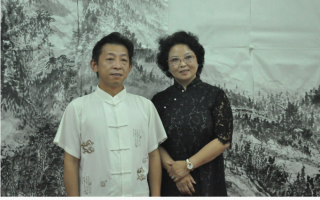
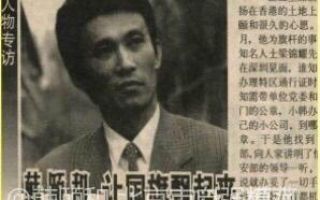
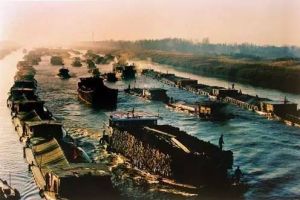
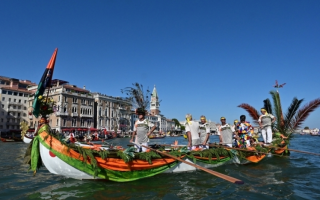
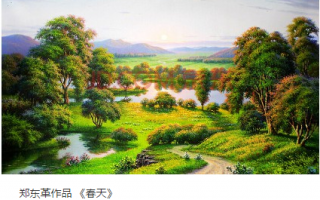
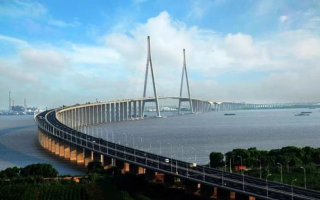
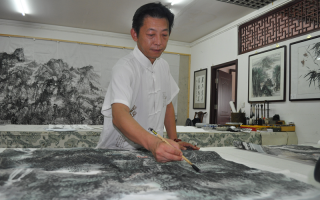
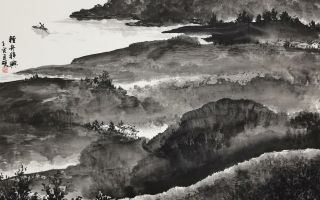
0 条 评 论 Write a Response